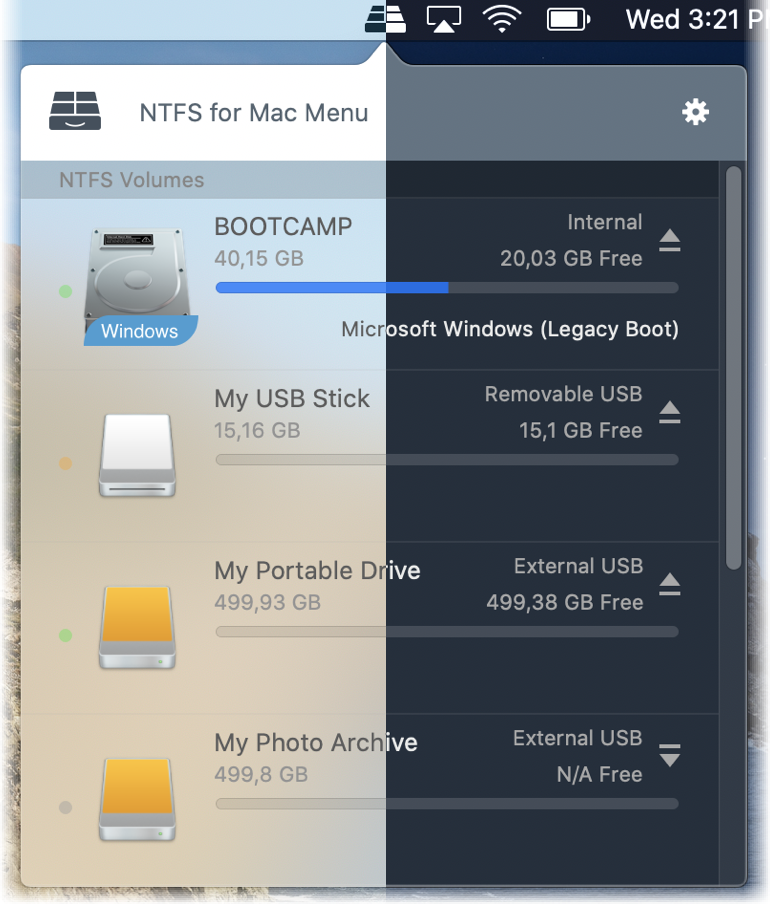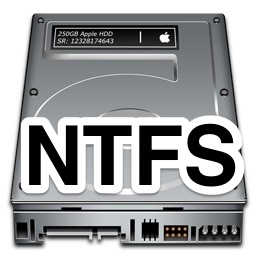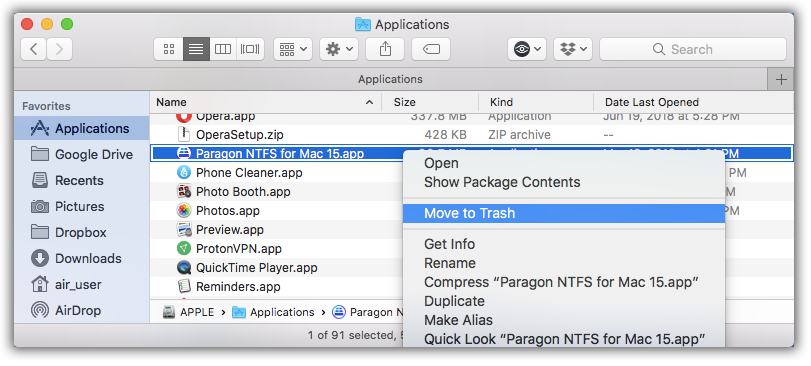- Ntfs driver for mac free download - Paragon NTFS for Mac, iBoysoft NTFS for Mac, Paragon NTFS for Mac Special Edition, and many more programs.
- Microsoft exFAT/NTFS for USB by Paragon Software is a universal non-root method for transferring files between onboard memory of your Android device and Windows or Mac-formatted USB Flash Drive. The app is fully integrated with Paragon File System Link document provider, based on Storage Access Framework (SAF), that ensures access to device storage, cloud storage services, USB storages.
Stable Operation
Fail-safe operability across compatible hardware and software systems for both general-purpose and specialized applications
Data Safety
I frequently work with NTFS, HFS+, APFS-formatted partitions on my Mac and Windows PC. Can I get a discount, if I buy all drivers at once? Yes, you can purchase our new Paragon Mac.
Protection of data integrity and prevention of accidental data corruption and possible loss
Guaranteed Performance
Steady throughput and balanced goodput with effective flow control, reduced overheads, and congestion avoidance
Efficient Use
Thrifty usage of processor, memory, and disk resources
Native look and feel
PC Advisor MagazineIt simply works out of the box too – previously inaccessible drives suddenly show up like any other, and you can now easily transfer data to and from a Mac using an external HFS+ formatted drive as an intermediary. There's no performance penalty either – we happily transferred multi-gigabyte files via a USB 2 connection at around 40MB/s, for example.
pcadvisor.co.uk
MacBreaker,Paragon HFS+ runs in the background and automatically starts on bootup, so accessing your Mac drives will feel exactly like accessing normal Windows drives.
macbreaker.com
MakeUseOf,Paragon HFS+ does cost $20, but it also offers a 10-day free trial. If you just need to recover files from a drive, 10 days is plenty of time to install this file system driver, copy your files over, and uninstall it. If you want to use Mac drives on Windows on an ongoing basis, paying $20 so you can use the drive properly is a pretty good deal. As a bonus, Paragon HFS+ doesn't require you have the insecure Java installed.
makeuseof.com
How it Works
Install
Download and install the HFS+ for Windows by Paragon Software
Use
Your drive will show up in Explorer
- Straightforward UI for working with HFS+ partitions as easily as native volumes
- Easy to navigate all features from a single application menu
- Check the integrity of HFS+ partitions to fix errors and view status report
- Quickly access HFS + partitions from the Windows taskbar
Features
Supported Operating Systems |
|
Supported File Systems |
|
Write Access | Act machine price. When a volume is mounted in write mode, you can do everything with files and folders it contains: read, edit, delete, rename, create new. |
Automount | HFS+ for Windows by Paragon Software mounts supported volumes automatically at startup, so you don't need to bother about it each time you restart the operating system or power your computer on. However, this feature can be disabled at any moment in the program interface. |
Internationalization | HFS+ for Windows by Paragon Software supports all alphabets supported by your operating systems, including those that use non-Roman and non-Latin characters, so you will never face a problem of not getting access to file names on volumes mounted in non-native OS. |
Support for journaling | HFS+ for Windows by Paragon Software supports native HFS+ journaling, thus ensuring that in case of any failure the disk file system is not irreversibly corrupted and can be put back on track easily. |
Compatible with Apple Boot Camp | HFS+ for Windows by Paragon Software is fully compatible with Apple Boot Camp software and provides direct read and write access to Mac partitions from Windows installed on a Boot Camp. |
Compatible with 3rd party software | HFS+ for Windows by Paragon Software is compatible with popular virtualization and encryption applications including VMware Fusion and Workstation, Parallels Desktop, TrueCrypt and its forks. |
Need APFS support for Windows 10?
GET APFS FOR WINDOWS NOW!
Full support of Windows 10, 8/8.1, 7 SP1
Availability to read and write data on APFS-formatted disks
Automount
Frequently Asked Questions
Due to the specifics of Windows 8 or Windows 10 Fast Startup feature, we highly recommend that you disable it before installing the driver to avoid possible file system corruption. For more details, please refer to the Microsoft Knowledge Base ››
Paragon Ntfs For Mac Driver
| Can I try the product for free before buying? | |
| |
| What versions of the HFS file system are supported? | |
| |
| Is APFS supported? | |
| |
| Is BootCamp supported? | |
| |
| Is Core Storage supported? | |
| |
| How many times can I re-activate my license? | |
| |
| It doesn't work! My HFS+ drive is not recognized in Windows, even after installing HFS+ for Windows by Paragon Software | |
| |
| The product doesn't run on Windows Server 2012 R2. | |
| |
| Can I open my Time Machine backup using HFS+ for Windows? | |
| |
| I frequently work with NTFS, HFS+, APFS-formatted partitions on my Mac and Windows PC. Can I get a discount, if I buy all drivers at once? | |
|
Ensure multi-platform access - activate required file system drivers based on your IT park, regardless of OS, in any proportion.
Resources
Current Version | Download Paragon HFS+ for Windows by Paragon Software |
Product Documentation | Download HFS+ for Windows by Paragon Software One Pager |
Product Tour | View Product Tour |
Need help? | Contact Support or file a support ticket |
Paragon Technology Center
Want to learn more about the technology behind Microsoft NTFS for Mac by Paragon Software? Check out the Paragon Technology Portal!
An NTFS, which is short for an NT file system (also known as New Technology File System) is the file system used on the Windows NT operating system. Windows NT (New Technology) was released in 1993, with the latest update in July 2018, with two versions available, one for Servers and the other for Workstations.
Comparable to other file systems, NTFS stores and retrieves files on hard disks. NTFS is the NT equivalent of the Windows 95 file allocation table (FAT) and the improved, OS/2 High Performance File System (HPFS). In Apple terms, NTFS is the NT equivalent of the Apple File System (AFS) for macOS and most of the recent iOS updates.
There are dozens of other file storage and retrieval systems; those are simply some of the most popular, and in this case, although macOS can read from NTFS drives, it can't write directly to a drive without some extra work and customization. NTFS drives can prove to be invaluable storage systems, making it especially useful for those with large files and Mac devices to connect them together with read and write functions.
Advantages of an NTFS for Mac
- Support to store very large files, up to 16 billion bytes in size (up to 2 to the 64th power). Wow!
- Information about a file's cluster is stored in each cluster, instead of that staying centralized, as is the case with the FAT file format.
- NTFS drives use a b-tree directory that keeps an accurate record of file clusters.
- An access control list (ACL) that keeps close and accurate record of who can access which files, with the ability to place restrictions on access as needed.
- Integrated and secure file compression.
- Support for file names based on Unicode formats.
- Support in place for much longer - and more secure - file names, including those based on the '8 by 3' name format.
- Data security in place on fixed and removable and remote disks, including those it connects to, such as those on a macOS device.
For anyone running out of space on a Mac, an NTFS drive sounds like an ideal solution. Or if you regularly use a Mac and NTFS drives, you are going to need an easy and effective way to connect both and use read and write functions.
Before or after connecting the two, you might want to make sure that you aren't storing more than you actually need. Storage space on any device or driver costs money. Even though an NTFS drive can store huge volumes, there is no sense passing junk, duplicate folders and things you don't need from one to another. To avoid doing that, try downloading CleanMyMac X. Designed to clear out tonnes of junk and unnecessary files and folders, this app makes your Mac as good as new.
CleanMyMac X can also scan and clear out unwanted junk in external hard drives, so running a scan when connected to an NTFS drive could save you a huge amount of space.
Before connecting and implementing write functions from macOS, let's take a glance at how an NTFS drive works.
How an NTFS drive for Mac works?
An NTFS drive automatically partitions and divides the physical space within a hard drive once its initialized. Windows NT creates automatic and pre-defined cluster format file sizes, depending on the overall space available, with recommended defaults pre-programmed into the operating system.
Cluster sizes within the NT operating system range from the smallest, at 512 bytes, up to 64 kilobytes. Windows NT puts in place default cluster sizes for hard drives of any given size. For example, a 4 GB drive will have a cluster size of 4 KB. How the system creates clusters depends on what someone is uploading to an NTFS drive.
Windows NT prefers to make a trade-off between accommodating large files and reducing the work it would take to access those files. Breaking a large file down into a smaller selection of clusters would improve performance, although this reduce space efficiency.
When a file is created or uploaded, a record is kept within the Master File Table (MFT) of the cluster locations within an NTFS drive. Again, in an attempt to ensure efficiency, Windows NT always attempts to allocate contiguous storage space that will hold as much of the file as possible, thereby keeping each cluster near one another in the record and file cluster format.
Assuming an NTFS drive connected to a Mac is a useful solution for your storage needs, there are three possible ways to connect read and write formats.

How to read and format NTFS on a Mac
#1: Third-party drivers (paid)
One of the quickest and easiest ways is to download a paid NFTS third-party driver solution that can support read and write functions.
Compared to other potential solutions for this problem, this is the quickest and safest way, and it involves an easier setup process. Many of them work well and have been tried-and-tested on thousands of Mac devices across the world.
Some solutions worth considering:


- Paragon NTFS for Mac. It costs $19.95 with a ten-day free trial and according to reviews, 'just works', so is considered worth the investment. As it says on the tin, it comes with read and write functions and effectively bridges the gap between macOS and Windows NT.
- Another way to get Paragon NTFS for Mac is to buy an NTFS Seagate drive, which comes with a free download of Paragon.
- Tuxera NTFS for Mac is another way of bridging the gap between macOS and Windows NT, although it costs $31.00, with a 14-day free trial. Similar to Paragon, just a little more expensive.
#2: Third-party drivers (free)
Another way to have read-write functions when connected to an NTFS drive is to download a free driver, known as FUSE. It isn't as quick or easy as the above option, and there are some security concerns related to this approach, but it should be mentioned in this list.
Here is how you download a free third-party driver (familiarity with Terminal is essential):
- Make sure you've downloaded and installed Apple's command line developer tools in Terminal before continuing. Input this in Terminal to install them:
xcode-select - - install - Click Install when prompted to ensure they are installed.
- Next, download Homebrew. Homebrew is a 'package manager' for Mac OS X and macOS and is pretty useful when using third-party tools such as FUSE.
- Once downloaded, copy and paste the following in Terminal:
/usr/bin/ruby -e '$(curl -fsSLhttps://raw.githubusercontent.com/Homebrew/install/master/install)' - Enter and input your password when prompted.
- With all of that done, you can enter the following command - again, in Terminal - to install FUSE:
brew install ntfs-3g.
Now you can manually run and mount read-write disk permissions between macOS and an NTFS drive. Terminal is the primary mechanism through which you can control these permissions and run or divide volumes and clusters.
Once you've connected a drive, you need to input the following command in Terminal once, to create a mount point at /Volumes/NTFS:
sudo mkdir /Volumes/NTFS
To get a list of the petitions, put this into Terminal:
diskutil list

How to read and format NTFS on a Mac
#1: Third-party drivers (paid)
One of the quickest and easiest ways is to download a paid NFTS third-party driver solution that can support read and write functions.
Compared to other potential solutions for this problem, this is the quickest and safest way, and it involves an easier setup process. Many of them work well and have been tried-and-tested on thousands of Mac devices across the world.
Some solutions worth considering:
- Paragon NTFS for Mac. It costs $19.95 with a ten-day free trial and according to reviews, 'just works', so is considered worth the investment. As it says on the tin, it comes with read and write functions and effectively bridges the gap between macOS and Windows NT.
- Another way to get Paragon NTFS for Mac is to buy an NTFS Seagate drive, which comes with a free download of Paragon.
- Tuxera NTFS for Mac is another way of bridging the gap between macOS and Windows NT, although it costs $31.00, with a 14-day free trial. Similar to Paragon, just a little more expensive.
#2: Third-party drivers (free)
Another way to have read-write functions when connected to an NTFS drive is to download a free driver, known as FUSE. It isn't as quick or easy as the above option, and there are some security concerns related to this approach, but it should be mentioned in this list.
Here is how you download a free third-party driver (familiarity with Terminal is essential):
- Make sure you've downloaded and installed Apple's command line developer tools in Terminal before continuing. Input this in Terminal to install them:
xcode-select - - install - Click Install when prompted to ensure they are installed.
- Next, download Homebrew. Homebrew is a 'package manager' for Mac OS X and macOS and is pretty useful when using third-party tools such as FUSE.
- Once downloaded, copy and paste the following in Terminal:
/usr/bin/ruby -e '$(curl -fsSLhttps://raw.githubusercontent.com/Homebrew/install/master/install)' - Enter and input your password when prompted.
- With all of that done, you can enter the following command - again, in Terminal - to install FUSE:
brew install ntfs-3g.
Now you can manually run and mount read-write disk permissions between macOS and an NTFS drive. Terminal is the primary mechanism through which you can control these permissions and run or divide volumes and clusters.
Once you've connected a drive, you need to input the following command in Terminal once, to create a mount point at /Volumes/NTFS:
sudo mkdir /Volumes/NTFS
To get a list of the petitions, put this into Terminal:
diskutil list
Ntfs For Mac Driver
Now every partition within the mounted drive should write and read the same way as any other external drive or device.
View and Download Chevrolet 2003 Silverado 1500 Pickup owner's manual online. 2003 Silverado 1500 Pickup automobile pdf manual download. Also for: 2003 silverado. Order Repair Manual for your 2003 Chevrolet Silverado 1500 and pick it up in store—make your purchase, find a store near you, and get directions. Your order may be eligible for Ship to Home, and shipping is free on all online orders of $35.00+. Check here for special coupons and promotions. View and Download Chevrolet 2003 Silverado owner's manual online. 2003 Silverado automobile pdf manual download. Chevrolet 2003 Silverado 1500 Pickup Owner's Manual 556 pages. Related Manuals for Chevrolet 2003 Silverado. 1-1 Service and Appearance Care.5-1 Front Seats Service. 2003 chevy silverado 1500 service manual.
#3: MacOS experimental NTFS-Write support
Wd Ntfs For Mac Driver
Another way - although one that isn't recommended because as of macOS 10.12 Sierra, it wasn't stable - and may never be stable, or secure, is to attempt an experimental NTFS-write support within macOS.
Before connecting the drive, make sure it has a convenient single word label.
Next, launch Terminal and enter the following command:
sudo nano /etc/fstab
Now add the following line to nano, replacing the placeholder 'NAME' used here with the name of your NTFS drive:
LABEL=NAME none ntfs rw,auto,nobrowse
Press Ctrl+O after entering that and then Ctrl+X to close nano.
With that done, connect the drive to your Mac and it should show up under /Volumes in a Finder window. It should appear, although with this being an experimental approach and one that isn't considered secure or stable, that can't be guaranteed.
Of the three approaches mentioned in this article, the safest and most secure approach is to download a paid third-party application. It is the easiest way to guarantee read and write access to an NTFS file.
